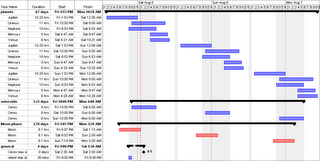Cindy et al.I prepared my palmtop, the laptop, consolidated files between them. In fact, I was getting a little worried I've been moving too much data onto the laptop. This is a loaner machine so I mustn't get too dependent on it. I considered carefully files and data that is better kept on the more portable palmtop. Still, I saved a local copy of the Belmont Society's colour double-star chart to the laptop.
I'm ramping up for another fun-filled astronomy weekend! RELAX, RELAX, I'm not showing up at your house again... Sheesh. Not unless I want to donate more pints to the Ajax Small Mobile Blood Bank! I'm heading westward this time, to my Mom's. You may recall she lives near the other lake, Erie, south of London.
I have the following items on my to-do list:
Clear skies!
- find Ceres asteroid (while it is in opposition)
- find Neptune
- retest "star drift" timings of my and my Mom's 4 eyepieces
- attempt my first long-duration tracked photograph of Jupiter and its big moons (using Mom's telescope and its clock drive), assuming the Moon will cooperate
- get up early and locate Mercury before sunrise
- track Mercury and Venus (again with Mom's telescope) into daylight hours
- find some colourful double stars
- memorise a few more new constellations
- track down some more galaxies!
- and maybe even build myself a light table (red light of course)
Blake
All the while I resisted printing. I knew I could keep the laptop near to me for sessions at Mom's, powered indefinitely, while working from her backyard deck. With her huge extension cords, I knew I could even move to the middle of the backyard or to the front yard. Or even the top of the garage roof! While correlating facts and figures on various web sites and in my RedShift software (I had never displayed asteroids before), I fired up Microsoft Project to help me get a better sense of timing issues! Excessive? Perhaps.

Say what you will, it helped me! I gained a much stronger sense of the best times to view Neptune and Ceres, when to attempt star trails and constellation photos, when to avoid the gibbous Moon. I set primary times and “rain dates.”
It was at this point that I decided to pull an all-nighter: Jupiter was up in the early evening; I could try for Neptune and Ceres in late night (after the Moon had set); then, before dawn, I would snag Mercury and Venus; and finally I would track Venus, with Mom's motorised 'scope, into the day time. An ambitious plan at the very least. Why I added twenty Messier objects to chase, I cannot--looking back--quite fathom!
Finally, I revised my log sheets.
§
As I edited my log sheets, I added a scale to show the Moon phase. For a moment I considered drawing the needed symbols but I remembered seeing (somewhere) a crescent in some of the Windows symbolic fonts. After a futile search, it occurred to me to look on the net.

Whereupon I stumbled across a complete “library” of Moon phase symbols, in white and black, from Curtis Clark's personal web page. Updated URL for this "old" font.


No comments:
Post a Comment